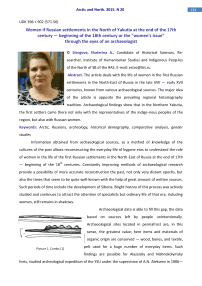Women if Russian settlements in the North of Yakutia at the end of the 17th century — beginning of the 18th century or the "women's issue" through the eyes of an archaeologist
Автор: Strogova Ekaterina A.
Журнал: Arctic and North @arctic-and-north
Рубрика: Culture of the Arctic and Northern peoples
Статья в выпуске: 20, 2015 года.
Бесплатный доступ
The article deals with the life of women in the first Russian settlements in the North-East of Russia in the late XVII — early XVII centuries, known from various archaeological sources. The major idea of the article is opposite the prevailing regional historiography tradition. Archaeological findings show that in the Northern Yakutia, the first settlers came there not only with the representatives of the indige-nous peoples of the region, but also with Russian women.
Arctic, Russians, archeology, historical demography, comparative analysis, gender studies
Короткий адрес: https://sciup.org/148318713
IDR: 148318713 | УДК: 396 + 902 (571.56)
Текст научной статьи Women if Russian settlements in the North of Yakutia at the end of the 17th century — beginning of the 18th century or the "women's issue" through the eyes of an archaeologist
Information obtained from archaeological sources, as a method of knowledge of the cultures of the past allows reconstructing the everyday life of bygone eras to understand the role of women in the life of the first Russian settlements in the North-East of Russia at the end of 17th — beginning of the 18th centuries. Constantly improving methods of archaeological research provide a possibility of more accurate reconstruction the past, not only very distant epochs, but also the times that seem to be quite well-known with the help of great amount of written sources. Such periods of time include the development of Siberia. Bright history of this process was actively studied and continues to attract the attention of specialists but ordinary life of that era, including women, still remains in shadows.
Picture 1. Combs [1]
Archaeological data is able to fill this gap, the data based on sources left by people unintentionally. Archaeological sites located in permafrost are, in this sense, the greatest value; here items and materials of organic origin are conserved — wood, bones, and textile, pelt used for a huge number of everyday items. Such findings are possible for Alazeisky and Nizhnekolymsky forts, studied archeological expedition of the YSU under the supervision of A.N. Alekseev in 1986—
1990. Research of the Nizhnekolymsky (Staduhinsky) fort was continued by the NPO group
“Northern archeology – 1” under the supervision of G.P. Vizgalov in 2009—2011. Among the materials there are items that can give an idea of the life of Russian women in the north of Yakutia at the end of 17th — beginning of the 18th centuries. All items associated with women could be divided into two categories: the tools for fiber processing, sewing and embroidery, and fro clothing and decorations.
The first category is represented by a wide range of tools. These include combs, beater, spinning wheels, spindles and whorls found during the excavations of Alazeisky and Nizhne- kolymsky forts. All of these tools are fixed product of characteristic shape. Lopaska of spinning wheels, unlike Siberian and Russian ones, are made quite rude and have no decorations in the form of thread or paintings. Wooden spindles are every interesting. No analogues could be found. They look like large wooden flat wheels with circular or square opening in the center, with a diameter of 15—25 cm. The large size of these spindles is for the whorl and is intended to stabilize the spindles, to facilitate the work of thread spinner and to make smoother. Usually spindles are made small, of stone or clay, I think, all will remember the famous Ovruchsky spindles from the rose slate, so popular in Russia in the 10th—12th centuries. Wood material is lightweight. So, to achieve the desired effect, it was necessary to increase the diameter of the spindles.
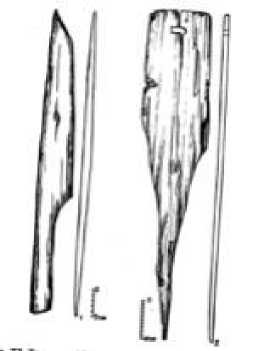
Picture 2. Beater and lopaska [1]
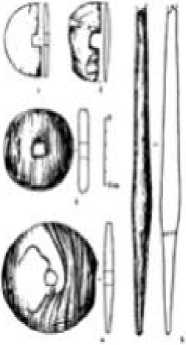
Picture 3.
Whorl and spindle [1]
In connection with the above, the question arises: what kind of fiber used the women in the Arctic, where the where flax did not grow? The answer to this question is given by the archeological ma-terials and modern ethnographic observations. During the excava-tions at the Nizhnekolymsky fort in 1989, knitted socks and felted siskin made from dog hair were found. Modern women the down-steams of Indigirka and Kolyma rivers successfully spun wool from the dog’s hair and knit beautiful and very warm clothes. Since traces of weaving have not been found yet in both forts, it could be assumed that in the studied time spun wool used the same way.
“Tools and materials for sewing and embroidery” represent the third category that includes needles, thimbles, needle bed and beads. The most numerous findings in this category are, of course, beads — they are found at both forts in amount more than 400 pieces. Beads are of good quality, of various calibers, mostly white, blue, green and black.
Beads and different types of necklaces were usual for the North of Yakutia in the 17th — beginning of the 18 centuries and were the subjects of exchange trade. Such kind of beads is mentioned by G.F. Miller as the most demanded at the local market [5, p. 530]. A part of the beads was found strung on a thread. So it is possible to talk about using them for embroidery in the settlements. Multi-colored glass beads are rare and have reached settlements as a part of jewelry, possibly, together with their owners.
Found needles are made of iron; they are of different thickness — from the thick ones that were used for sewing leather, to thin bead needles found this year. Thimbles, found at Russian settlements of the 17th — beginning of the 18 centuries, are metal, of different size: from true women small ones, to fairly large, suitable for men's
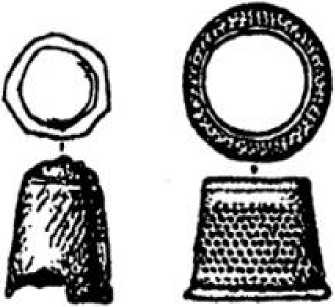
fingers. A part of thimbles has a closed top, and a part — open. Needle cases are tubes made of cooper or bone (long bones of animals or birds); inside — a place for needles, pinned on a small piece of leather or fabric.
In 2011, during the excavations of the Nizhnekolymsky wintering in a layer

picture 4. thimbles [1] dating from the late 17th century, well- preserved women headdress [2] was found. Its design is interesting because along it there is roll of tightly twisted red cloth covered by main tissue (Pic. 6). At first the headdress was interpreted as povoynick with a roller, which could be found in the
book of D.K. Zelenin on traditional Russian women headdresses. Povoynik is considered as local tradition of the Velikoustyuzhsk County of the Vologda Province [3,

p. 26]. The study of the collection of hats in the funds of Velikoustyuzhsk State Picture 5.
Needle case [1]
Historical and Architectural Museum-Reserve has shown that all traditional povoynik
— “marhatka” of this region have the inside roll of fabrics, stuffed with tow linen, sewn in order to make a desired shape of the headdress (Pic. 7). At the same time, among all hats represented in the collection of Velikoustyuzhsk museum, the closest design to that found was the Kolyma volosnik. This headpiece is a soft round hat made of red silk; on the top of it — a roll of fabrics which is sewn “on vzderzhku” — a way the top of the headdress was made with an open crown. At the junction of the main part and the top was sewn from thick cushion of a roll of canvas, sheathed by yellow silk and the bottom of the headdress was made of blue silk. This type of headdress — volosnik or samshura used with a round kokoshnik, that was traditionally worn by women of the northern regions of the Velikoustyuzhsk County, on the border with the Arkhangelsk Province and is now included in the Arkhangelsk region.
The so-called “women's issue” is one of the most debated issues in the study of the development of Russian Siberia. Specialists in Siberian studies of the 18th — early 20th centuries wrote a lot about small amount of Russian women in Siberia and their absence in the remote Siberian areas. Such an approach was traditional for Siberian studies. The gender misbalance problem took place, according to the numerous written sources, but it was solved quite well, and the beginning of the 18th century in the western regions of Siberia an imbalance has been eliminated [4]. Even in such a remote region of Siberia, as Yakutia, despite the common opinion, by the end of the 17th century the number of Russian women approached normal, as it is evidenced by the fact that the Russians married Russian in the early 18th century even in such a “bear corner” as Nizhnekolymsk [6, p. 129].
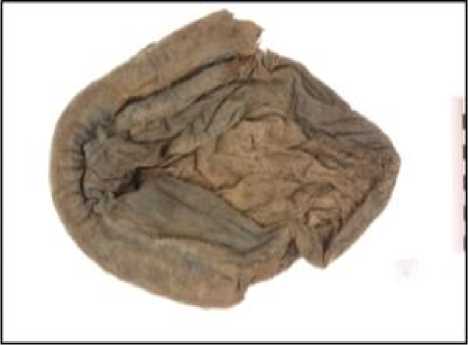
Picture 6. Povoynik. 17th-beginning of the 18th centuries, Nizhnekolymsk wintering
Thus, in the Russian settlements abandoned far beyond the Arctic Circle in 17th—18th centuries representatives of the beautiful half of humanity felt themselves quite confident. They were engaged in the usual kinds of women's needlework — spinning, beaded embroidery and processing of animal skins, which then were used for sewing clothes and knitting. Contrary to the common views, it is possible to say that on only “beautiful Yukagirs” who used stone scrapers and bone needles for their work, but Russian women as well. Tools for spinning found by archeologist give as a reason to say so. Especially if we will point out that spinning technique was unknown to indigenous peoples of the North of Yakutia. And if the earrings could be a bargaining chip or a gift, the traditional northern Russian povoynik would hardly be worn by the local Siberian women.
Список литературы Women if Russian settlements in the North of Yakutia at the end of the 17th century — beginning of the 18th century or the "women's issue" through the eyes of an archaeologist
- Alekseev A.N. Russkie poseleniya XVII—XVIII v. na Severo-Vostoke Yakutii [Russian settlements in 17th—18th centuries on the North-East Yakutia]. Novosibirsk, 1996.
- Vizgalov G.P. Arkheologicheskie issledovaniya Stadukhinskogo poseleniya (Nizhnekolymskogo ostroga) v Nizhnekolymskom rayone Respubliki Sakha (Yakutiya) v 2011 godu [Archaeological research of the Stadukhinskogo settlement (Nizhnekolymsky fort) in the Nizhnekolymsky district of the Republic of Sakha (Yakutia) in 2011]. Nefteyugansk, 2012. 360p.
- Zelenin D.K. Zhenskie golovnye ubory vostochnykh (russkikh) slavyan [Women's hats of Eastern (Russian) Slavs]. Praga, Slavia, vol. II (1926), vol. III (1927).
- Klotchkov M. Naselenie Rossii pri Petre Velikom po perepisyam togo vremeni, v 2-kh tomakh [Population Russia under Peter the Great on the census of that time, in 2 volumes]. St. Petersburg, 1911.
- Miller G.F. Izvestiya o torgakh Sibiriskikh [News of the markets in Sibir] Ezhemesyachnye sochineniya, 1755, no. 12, p. 530.
- Strogova E.A. Russkoe naselenie Yakutii v XVIII v. (istoriko-demograficheskoe issledovanie) Diss. Dokt.istir. nauki [Russian population of Yakutia in the XVIII century. (Historicaldemographic study ment)Doc. diss.]. Yakutsk, IHRIPN RAS, 2004.

